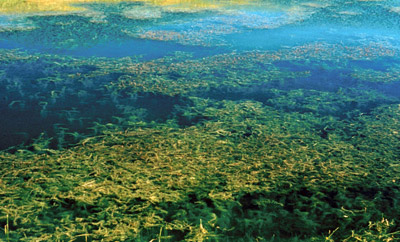Shedd Aquarium

Back to Shedd Aquarium
Back to Shedd Aquarium
Then add aquatic invaders
For centuries, humans have been moving plants and animals to new homes – sometimes accidently, sometimes not. In their new environment, some non-native species can force out native ones and wreak havoc on ecosystems and economies. The Great Lakes is now home to roughly 200 non-native fish, invertebrates, plants, and microscopic organisms. Some of these, like zebra mussel and round goby, have permanently impacted the health of the lakes. And many more aquatic invasive species (AIS) like these lurk on the horizon.
At the heart of AIS concerns is the impact they have on food webs. Without natural predators to keep them in check, invasive species can quickly outnumber and outeat native species. In Lake Michigan, the spiny water flea has actually wiped out entire species of plankton, the backbone of aquatic food webs, and left behind too little food for native crustaceans and some fish to survive. Invasive aquatic plants can also choke off waterways, forming dense mats that block out sunlight needed by other species. This also makes boating and swimming difficult.
It is nearly impossible to get rid of invasive species after they have been introduced to a new area. The key is prevention, and there is a lot that people can do to help stop the spread. Next time you go fishing, boating, or even swimming in a lake or river, make sure you remove any plants or animals on your equipment and wash and dry everything before you leave. Plant non-invasive species in your water gardens and aquariums. And be careful that you don't dump plants, fish, or animals into any water body.
At the heart of AIS concerns is the impact they have on food webs. Without natural predators to keep them in check, invasive species can quickly outnumber and outeat native species. In Lake Michigan, the spiny water flea has actually wiped out entire species of plankton, the backbone of aquatic food webs, and left behind too little food for native crustaceans and some fish to survive. Invasive aquatic plants can also choke off waterways, forming dense mats that block out sunlight needed by other species. This also makes boating and swimming difficult.
It is nearly impossible to get rid of invasive species after they have been introduced to a new area. The key is prevention, and there is a lot that people can do to help stop the spread. Next time you go fishing, boating, or even swimming in a lake or river, make sure you remove any plants or animals on your equipment and wash and dry everything before you leave. Plant non-invasive species in your water gardens and aquariums. And be careful that you don't dump plants, fish, or animals into any water body.
